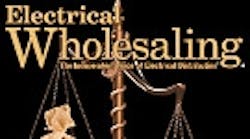One of the worst steel shortages in history is squeezing electrical manufacturers already struggling to cope with a downturn in the economy and rising fuel surcharges.
Steel prices are rising dramatically, forcing manufacturers to increase prices by at least 5 percent to 10 percent on steel products.
“The cost of hot-rolled sheet steel peaked in 2004 at about $820 per ton. Now we're looking at $1,000 and the steel mills have made it real clear that that's not the end of it, so it's going to go up even higher,” says David Burnette, national sales manager, Electrical Division, Wheatland Tube, Swarthmore, Pa.
Since the beginning of the year, the cost of hot-rolled steel is up 81 percent; cold rolled is up 69 percent; and galvanized steel is up 54 percent. The spot prices on flat-rolled steel are now at the $1,000 mark. About a year ago, it was selling at about $650 to $700 a metric ton.
Many manufacturers and reps are calling the steel crisis the worst they have seen, or at least since a similar steel spike in 2004. Don Brody, vice president of sales for Hubbell Electrical Products, says steel prices seem to be escalating at a faster pace than they did in 2004. “In 2004, the mills were raising prices. Now it is their coke and ore suppliers as well taking advantage of the global demand for steel.”
“Steel is a predominant material used in all of our electrical products, which includes conduit, metal framing, cable trays, armored cable and fittings,” says Jim Hays, vice president of Allied Electrical Group, Harvey, Ill., a business unit of Tyco Electrical & Metal Products. “As a major consumer of steel, we have been experiencing ongoing increases from our steel suppliers since the beginning of the year. These increases have caused the price of steel to more than double. We foresee steel prices continuing to rise possibly through the end of 2008.”
According to the electrical manufacturers EW interviewed, factors for the price increase include rising material costs, a weak U.S. dollar, strong global demand, higher energy cost, the global consolidation of the steel industry, unexpected plant shutdowns and much higher energy and transportation costs.
Brody of Hubbell Electrical Products says the root cause of the steel price increases is “two-fold demand and the mill consolidation, with those remaining operators limiting production to keep the prices at a level to meet their profit objectives.”
Citing high raw materials costs, the world's largest steel marker, ArcelorMittal, recently sent a letter to U.S. auto makers and other U.S. contract customers saying that it would apply a rare $250-a-ton surcharge to the price negotiated in existing contracts, according to an April 26 article in The Wall Street Journal. That affects all the major automakers, who have no choice but to pay because of the tight steel market worldwide. The other steel companies are following suit.
Many electrical manufacturers see similarities between the current steel crisis and the last steel crisis in 2004. “This is parallel to what we saw four years ago when the mills would not honor their blanket contracts and would raise prices on a monthly basis based on the demand,” says Hubbell's Brody.
Allied Tube saw similar increases in steel prices in 2004, but says current steel prices have exceeded the peak levels experienced back then. Hays says the big difference between this crisis and the one in 2004 is that during that time there was a real shortage of steel. “Today steel supply is very tight, but the market is not experiencing the shortage in supply like it did in 2004,” he says.
Distributors are also doing a better job managing their inventories. “I think distributors learned a very good lesson in '04 about waking up with bloated inventories,” says Burnette of Wheatland Tube. “Some customers might complain that they could have made more money by buying more before steel prices rose even higher, but at some point there will be a correction. “The question will be, ‘Where does it correct to?’ We have customers with healthy inventories. There are very few distributors that I see out there that have what I would call bloated inventories.”
While demand for steel conduit is ahead of the first three months of last year, Burnette says, “The issue is how much of that is forward buying. It's hard to put your finger on it. We would guess 15 percent is contractors forward-buying material that they know they will need later this spring or summer.”
Manufacturers, who are unable to predict steel prices from week to week, have been forced to pass along price increases to other companies along the supply chain.
Hubbell Electrical Products announced an increase of 8 percent on April 1 and said at press-time it planned to announce another increase for May. Brody said there would be more price increases, as long as the global demand continues to be robust and the mills manage their production to keep the demand equal to the production.
Wheatland Tube began raising prices in January, says Burnette, but as the situation worsened the company has recently begun to raise prices on a weekly or biweekly basis. Implementing price increases of 2 percent to 5 percent on a more frequent basis seems to be working well because it is not as much of a hardship on customers, he says. “What we're trying to do on the electrical side is ramp it up where it's not a shock,” he says.
While customers don't like the increased steel costs, most seem to understand the reasons and the need for them, say several manufacturers. “I think they are very aware of what is happening to the base material increases,” said Hubbell Electrical Products' Brody. “They may not like it at the contractor level, but it is something that they have come to expect. Hays of Allied Tube says customers and end-users seem to be more accepting of steel price increases this time than they were in 2004. “During the early days of 2004, there was a lot of resistance because no one had experienced such increases in steel since the early 1970s,” says Hays. “This time around, customers and end users seem to be adjusting their cost and resale price structure a lot faster. We continue to make sure our sales force and customer/partners are kept appraised of the ongoing escalation in raw material costs.”
Burnett says that when Wheatland Tube was talking to customers about the steel situation back in November and December of last year, customers were very skeptical. “Now almost everyone seems to be in tune with what is going on,” he says.
Moving to a New Price Band
2004 essentially established a new level, says John Anton, director of Global Insight Steel Service, Waltham, Mass. “Prices for almost every steel product doubled in 2004,” he says. “Quite a few steel products tripled. There was a partial retreat in 2005.”
Anton doesn't see steel price increases ending anytime soon. “I think they rise through the second quarter,” he says. “Third quarter is unsettled, but generally prices will move sideways. And then prices start cracking in the fourth quarter and by mid-2009, prices should be approximately what they were in mid-2007. But there will be a big peak in between.”
With steel prices rising to record levels, there is little chance of them returning to the price levels they were at before 2004, he says.
“The simple statement is the new floor is higher than the old ceiling,” he said. “For hot-rolled sheet, a $380-a-ton price was extraordinary in the first years of this decade. Steelmakers were jumping up and down for joy at their profits. I can't see the price in our worst recession scenario moving below $450 now as a floor. So the new floor is higher than the old ceiling. And generally I see hot-rolled sheet staying $550 to $600 per ton. It was around $300 to $330 per ton early in this decade.”
Says Jim Hays of Allied Electrical Group, “It is all speculative. However, we see this cycle lasting toward the end of 2008. Similar to oil, gasoline, and other commodities, it does not appear likely that steel prices will return to old levels.”










